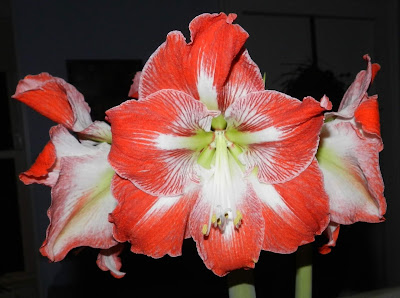 |
| 2011: "Along the Way" daylily blooming in full sun and happy! |
I may plant an annual in less than optimal conditions and baby it all summer, but I seldom plant a perennial in conditions too far off perfect. To do so, means they must be babied year after year, they never live up to expectations and they may eventually die. Loss of labor and money.
 |
| 2017: Almost total shade, competing with an ornamental grass and not happy. |
- The bed has become covered in shade most of the day.
- Other plants' root systems may become wide-spread taking moisture and nutrients.
- The drainage may change due to construction or landscaping.
Generally, the perfect conditions for daylilies in Zone 5 or north:
- Full sun.
- Some will enjoy some late afternoon shade in the heat of late summer. All require at least 6 hrs. of direct sun a day.
- Not sit in standing water.
- Regular moisture.
- Healthy soil prior to planting.
- Mulch to insulate roots from too much heat and cold.

2018: Moved into full sun and loving it.
Diseases:
- Fortunately, there aren't a lot of diseases this far north. The nasty run of rust in areas where there is no freeze won't be an issue here.
- Different virus can come in several ways, symptoms can mimic other things, it's difficult to diagnose and there's no cure. If you want to do anything to have disease free plants, only buy from reputable sources and never buy a daylily if the leaves look diseased (even if they may not be.)
- Root and crown rot are not typically seen unless the ground is too wet or the plant has been overly fertilized.
Want more? Check out the American Daylily Society's web page: http://daylilies.org
Note: The American Hemerocallis Society is changing it's name to American Daylily Society. It means the same thing but is easier to pronounce.
Both of these pictures are of the featured "Along the Way" daylily. The bottom one has bloomed in mostly shade; the top in full sun. Both are pretty but the top one is stunning and all that this variety can be. It has deep colors: the petals have subtle shimmering-gold overlaying the peach and the halo a dark maroon red. The bud count and number of scapes in the sun example has increased over ten times. The scapes are more sturdy and the flowers more robust.
If you pay good money for a perennial, don't plant in less than optimal conditions and if less optimal develops over the years, then move it or amend the conditions.
Note: If you click on the first picture, it will take you through them in a larger format - allowing you to see all the little pretties.





















